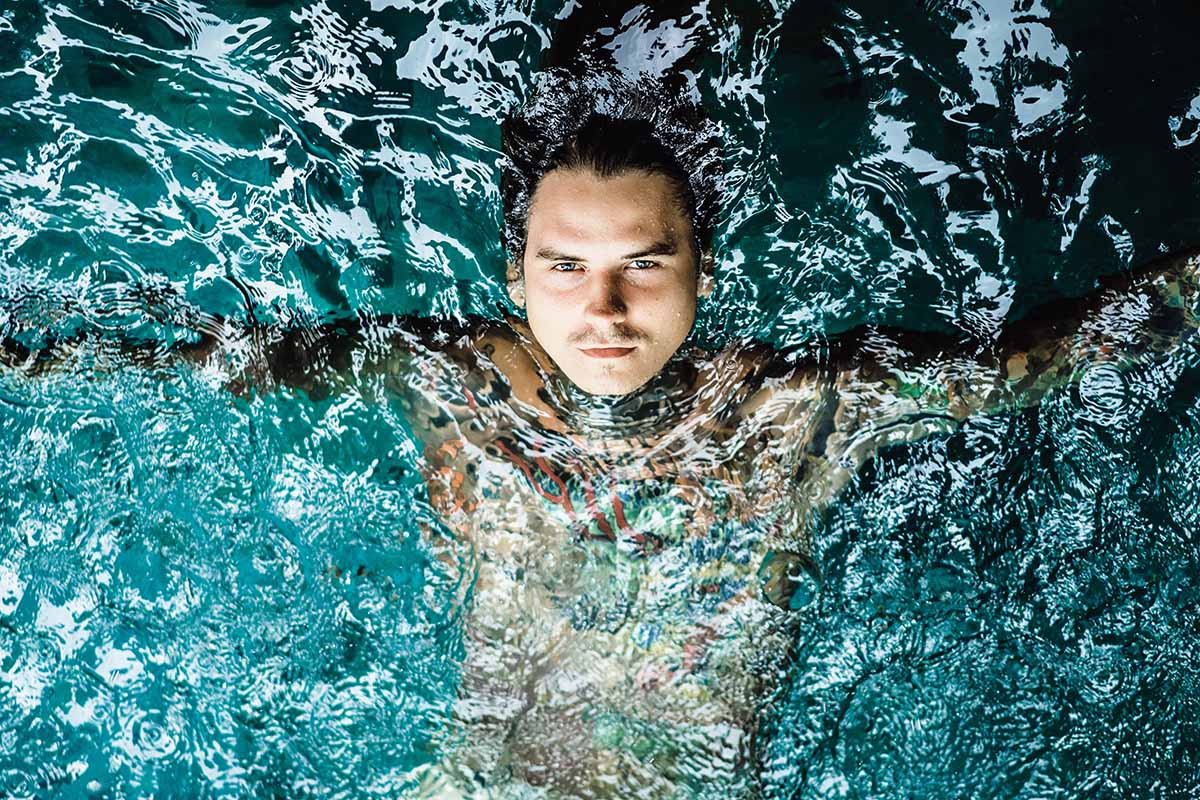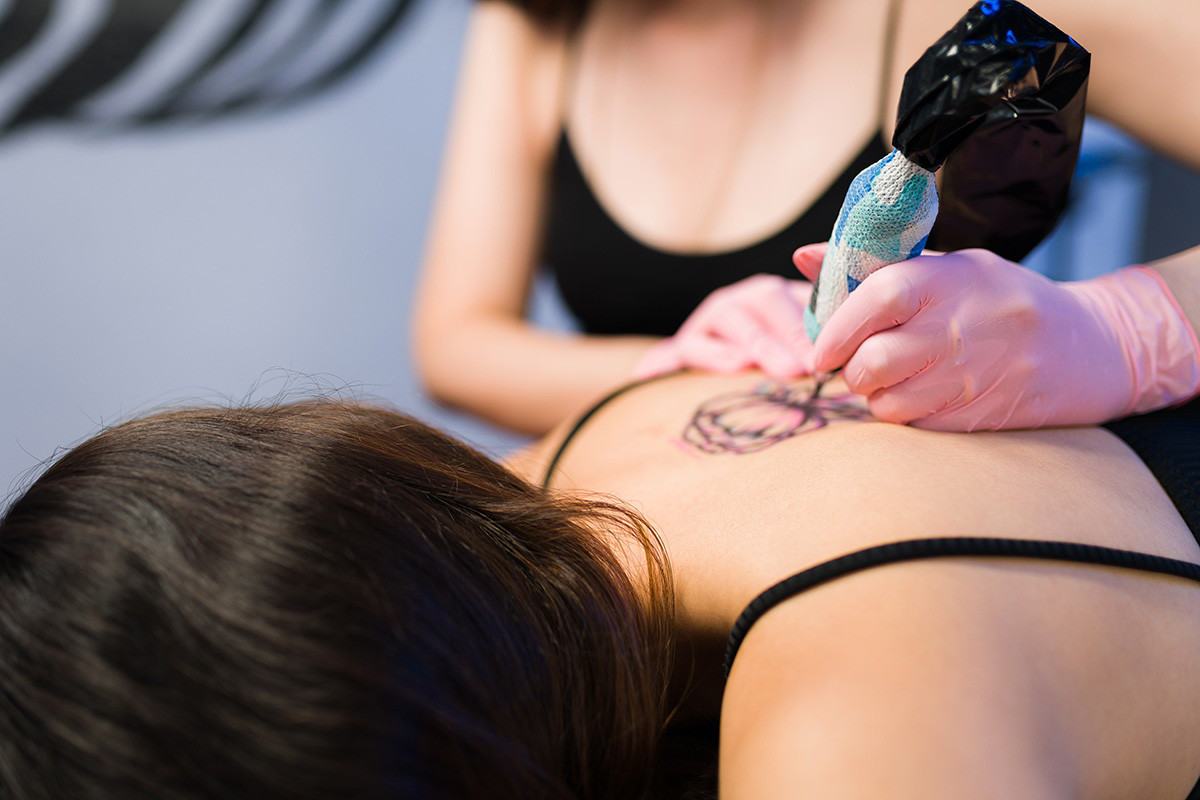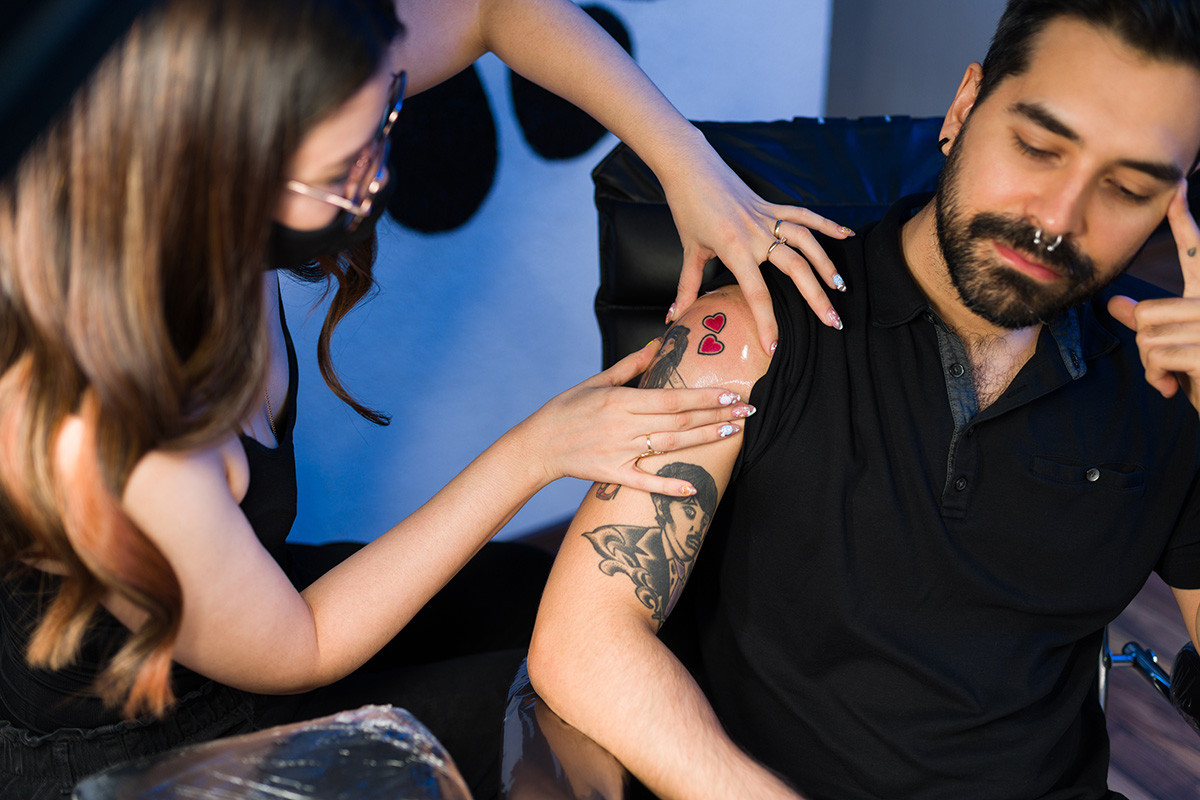Have you just gotten a cool new piece of body art and are now wondering, “Can I Get In The Pool After Getting A Tattoo?” At tattooat.com, we understand the excitement of wanting to show off your fresh ink. However, it’s crucial to understand the aftercare process to ensure your tattoo heals properly and remains vibrant. Let’s explore the best practices for protecting your new body art during the healing process and beyond with tattoo healing advice, tattoo aftercare tips, and preventing tattoo infection.
1. When Can You Dive In? Understanding the Tattoo Healing Timeline
Getting a new tattoo is super exciting, but you have to remember that aftercare is important for the health and appearance of your new skin art. Tattoos are like open wounds, and swimming too soon can cause bacterial infections, irritation, and damage to the design. Tattoo artists usually recommend waiting 2-4 weeks before you go swimming in pools, hot tubs, or open water.
Healing times can be different depending on the tattoo’s size and location, your skin type, and how well you take care of it. To make sure everything goes well, it’s important to know about the tattoo healing stages and things that can change the healing time.
1.1 The Stages of Tattoo Healing
The tattoo healing process goes through swelling, pain, and oozing in the first few days, then itching, peeling, and aftercare. It can take 2 to 4 weeks to heal, but sometimes up to 6 months. During this time, avoid swimming and things that can irritate your skin and make healing take longer.
It can be tempting to swim while your tattoo is healing, but remember that open water has the highest risk of infection. Infections can make healing take longer and even damage your tattoo. It’s best to be patient and wait until your tattoo is fully healed before you go swimming.
 A person getting a new tattoo and the healing process
A person getting a new tattoo and the healing process
Alt text: Tattoo artist working on a client’s arm, illustrating the beginning of the tattoo healing process.
1.2 Factors Affecting Tattoo Healing Time
Several things can change how long it takes for a tattoo to heal. These include:
| Factor | Description |
|---|---|
| Tattoo Size | Bigger tattoos take longer to heal. |
| Tattoo Location | Some body areas heal slower. |
| Aftercare Quality | Good aftercare helps speed up healing. |
| Individual Skin Type | Some skin types heal slower. |
| Swimming | Waterproof dressings can protect your tattoo while swimming. |
Your skin type can also affect how long a tattoo takes to heal. It’s important to watch the healing process and ask your tattoo artist if you have any questions before you swim.
2. Why Swimming with a Fresh Tattoo is Risky
Swimming with a new tattoo can cause problems for your new body art. Water can dry out the skin, causing itching, flaking, and scabbing. This can also cause fading, patchiness, and blurry lines in your new ink, which is not what you want.
Besides the pain and possible damage to your tattoo, swimming with a new tattoo can also cause infections. Pools, lakes, and oceans have bacteria, and your healing tattoo is an open wound that can be infected. Protect your tattoo and make sure it heals well by avoiding swimming until it’s fully healed.
2.1 Bacterial Infections and Open Wounds
Tattoos break the skin and put ink into your body, so they are considered open wounds. When you swim with a healing tattoo, you expose it to bacteria in pools, lakes, and oceans. This can cause irritation, infection, and other problems that can hurt your tattoo and make healing take longer.
To lower the risk of infection, keep your new tattoo clean and away from water. Waterproof dressings and bandages can protect your tattoo from bacteria while swimming. It’s always better to be safe than sorry when it comes to your tattoo’s health.
2.2 Chlorine and Salt Water Effects on Tattoos
Chlorine and salt water can be bad for your new tattoo. They can cause:
- Irritation
- Fading
- Discoloration
- Ink Leaching
Even if you’re swimming in a pool with chlorine, remember that chlorine doesn’t kill all bacteria and can still be risky for your healing tattoo.
Chlorine and salt water can also dry out the skin. This can make irritation worse and make healing take longer. To make sure your tattoo heals well and stays vibrant, avoid swimming until it’s fully healed.
3. Tattoo Protection: How to Protect Your New Tattoo While Swimming
 A person protecting their new tattoo while swimming with waterproof dressings and bandages
A person protecting their new tattoo while swimming with waterproof dressings and bandages
Alt text: Swimmer with a protected tattoo using waterproof bandage.
If you have to swim before your tattoo is fully healed, you can take steps to protect your new ink. Using waterproof dressings and bandages can protect your tattoo from water and bacteria while swimming. Take off the dressing right after swimming and clean your tattoo well to lower the risk of infection.
Swimming with a new tattoo is not recommended, and these steps don’t guarantee that your tattoo will be safe from infection or damage. It’s always best to wait until your tattoo is fully healed before swimming. If you have to swim, take the necessary steps to protect your body art.
3.1 Best Waterproof Dressings and Bandages for Tattoos
Waterproof dressings and bandages can save you if you need to swim with a new tattoo. These coverings create a barrier between your tattoo and the water, protecting your new ink from bacteria.
Some good waterproof dressings for a new tattoo include:
- Saniderm Tattoo Aftercare Bandage
- Recovery Derm Shield Tattoo Aftercare Bandage
- Tattoo Aftercare Waterproof Bandage
- Nexcare Tattoo Bandages
- Nuanchu Waterproof Bandage
Apply the dressing before swimming and take it off right after, changing it often to keep your tattoo protected.
3.2 Post-Swim Tattoo Care
After swimming, it’s important to clean and care for your tattoo to lower the risk of infection and damage. Here’s what to do:
- Wash the tattoo with warm water and mild soap.
- Pat the area dry with a clean towel.
- Apply a thin layer of fragrance-free moisturizer to keep the skin hydrated and help it heal.
Post-swim care is important for keeping your tattoo healthy and looking good. Protect your new ink by taking the necessary steps to make sure it heals well and looks great for years.
4. Signs Your Tattoo Is Ready for Swimming: What to Look For
Once your tattoo is fully healed, you can swim without worrying about damage or infection. How do you know when your tattoo is healed and ready to swim? Some signs that your tattoo is fully healed include no redness, itching, scabbing, or flaking, and a smooth appearance with no peeling.
If you’re not sure if your tattoo is fully healed, ask your tattoo artist or a doctor before you swim. They can check your tattoo’s healing and tell you when it’s safe to swim.
4.1 Visual Indicators of a Healed Tattoo
Visual indicators can help you know if your tattoo is ready for swimming. Look for no bubbling or degradation, no redness or peeling, and a smooth appearance with no flaking or scabbing. If your tattoo looks like this, it’s probably healed and safe to swim.
Everyone heals differently, so watch your tattoo closely during the healing process. If you have any questions or see anything unusual, contact your tattoo artist or a doctor.
4.2 Why You Should Consult Your Tattoo Artist About Tattoo Healing
Your tattoo artist is helpful for knowing if your tattoo is ready for swimming. They know about the healing process and can check your tattoo’s progress, giving you advice on when it’s safe to swim.
If you’re not sure if your tattoo is fully healed, visit the studio where you got your tattoo and have a professional check it. It’s better to be safe and make sure your tattoo is fully healed before you swim. According to Inked Magazine, consulting with your tattoo artist ensures you receive personalized aftercare advice tailored to your specific tattoo and skin type.
5. What Are Some Alternative Water Activities During Tattoo Healing?
 A person enjoying alternative water activities during the tattoo healing period
A person enjoying alternative water activities during the tattoo healing period
Alt text: Individual enjoying a gentle shower during the tattoo healing phase.
If you want to be in the water while your tattoo is healing but don’t want to risk damaging it, you can do other water activities. Instead of swimming, take gentle showers and avoid direct water jets. Boiling tap water for cleaning is another way to lower the risk of infection.
Keep your new tattoo clean and away from water during the healing process. By choosing other water activities, you can still enjoy the water while making sure your tattoo heals well and looks good.
6. Staying Away from Hot Tubs, Saunas, and Other Water Hazards
Hot tubs and saunas can be relaxing, but they can be risky for your new tattoo if you go too soon after getting it. The warm, moist environment in hot tubs and saunas can cause infections and slow down the healing process. It’s best to wait 3-4 weeks after getting a tattoo before going into a hot tub or sauna.
Avoid hot tubs, saunas, and other water-based places during the healing process to protect your new tattoo and make sure it heals well. Once your tattoo is fully healed, you can enjoy your favorite water activities without worry.
7. Tattoo Aftercare: A Summary
Knowing about the tattoo healing process and the risks of swimming too soon after getting inked is important for protecting your new art. By following aftercare advice, using waterproof dressings when needed, and waiting until your tattoo is fully healed before swimming, you can make sure it heals well and stays vibrant.
Whether you’ve had many tattoos or it’s your first time, it’s important to care for your new tattoo. Before you swim, make sure your tattoo is ready—patience is key to keeping your ink beautiful.
According to research from Portland State University’s Art Department, in July 2023, proper aftercare, including avoiding prolonged water submersion, significantly reduces the risk of tattoo-related complications.
Dive Deeper into the World of Tattoos at tattooat.com
Ready to explore more about tattoo designs, find talented artists, and learn the best aftercare practices? Visit tattooat.com to discover a wealth of inspiration, connect with top-rated studios, and gain the knowledge you need to make your tattoo journey a success. Find everything from tattoo ideas to aftercare guides, all in one place.
Frequently Asked Questions
8.1 What Happens if You Swim While Your Tattoo Is Healing?
Swimming with a new tattoo is dangerous. Your wounded skin is exposed to bacteria in the water that can cause infections, from mild to severe. It can also irritate the skin, causing itching, oozing blisters, and hives. To protect your tattoo, don’t swim while it’s healing.
8.2 Can I Swim 7 Days After Getting a Tattoo?
You should wait for your tattoo to fully heal, which can take at least two to four weeks, before swimming. Swimming before then can cause infection because bacteria or germs can enter an open wound.
8.3 How Long After Getting a Tattoo Can You Swim in Chlorine?
Wait at least two weeks, or up to four to six weeks, after getting a tattoo before swimming in chlorinated water. Don’t risk infection by swimming too early.
8.4 Can I Use Waterproof Dressings to Protect My Tattoo While Swimming?
Yes, you can use waterproof dressings to protect your tattoo while swimming, but make sure it’s fully healed first.
8.5 What Are the Risks of Swimming With a Fresh Tattoo?
Swimming with a new tattoo can cause bacterial infections, skin irritation, and damage to the design. It’s best to avoid swimming for the first few weeks after getting a new tattoo. Take steps to make sure your tattoo heals well. Waiting before swimming can help you avoid problems.
8.6 How Do I Choose the Right Tattoo Artist?
Choosing the right tattoo artist involves researching their portfolio, reading reviews, and ensuring they have a clean and sterile environment. At tattooat.com, we provide a curated list of talented artists and reputable studios across the USA to help you make an informed decision.
8.7 What Are the Best Tattoo Aftercare Products?
The best tattoo aftercare products are fragrance-free, hypoallergenic, and designed to keep the skin moisturized without clogging pores. Popular options include Aquaphor, Hustle Butter Deluxe, and specialized tattoo balms. Always consult with your tattoo artist for their specific recommendations.
8.8 How Can I Prevent My Tattoo From Fading?
Preventing tattoo fading involves protecting it from sun exposure, keeping your skin moisturized, and avoiding harsh chemicals. Use sunscreen with a high SPF, stay hydrated, and follow your tattoo artist’s aftercare instructions closely.
8.9 What Should I Do If I Think My Tattoo Is Infected?
If you think your tattoo is infected, look for signs like excessive redness, swelling, pus, and fever. Consult a medical professional immediately for treatment. Do not try to treat an infected tattoo on your own.
8.10 Are There Any Natural Remedies for Tattoo Healing?
While some people use natural remedies like coconut oil or aloe vera for tattoo healing, it’s important to consult with your tattoo artist or a dermatologist before using any alternative treatments. Ensure that the remedies are safe and won’t cause allergic reactions or interfere with the healing process.
